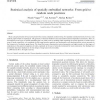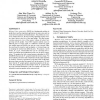267 search results - page 27 / 54 » Anti-Ramsey properties of random graphs |
IJON
2007
13 years 8 months ago
2007
Many conceptual studies of local cortical networks assume completely random wiring. For spatially extended networks, however, such random graph models are inadequate. The geometry...
CORR
2007
Springer
13 years 8 months ago
2007
Springer
Abstract— We consider the level of information security provided by random linear network coding in network scenarios in which all nodes comply with the communication protocols y...
SIGMOD
2010
ACM
14 years 1 months ago
2010
ACM
Maximal clique enumeration (MCE) is a fundamental problem in graph theory and has important applications in many areas such as social network analysis and bioinformatics. The prob...
CCS
2010
ACM
13 years 7 months ago
2010
ACM
Social network-based Sybil defenses exploit the trust exhibited in social graphs to detect Sybil nodes that disrupt an algorithmic property (i.e., the fast mixing) in these graphs...
ML
2010
ACM
13 years 7 months ago
2010
ACM
Scientific literature with rich metadata can be represented as a labeled directed graph. This graph representation enables a number of scientific tasks such as ad hoc retrieval o...


